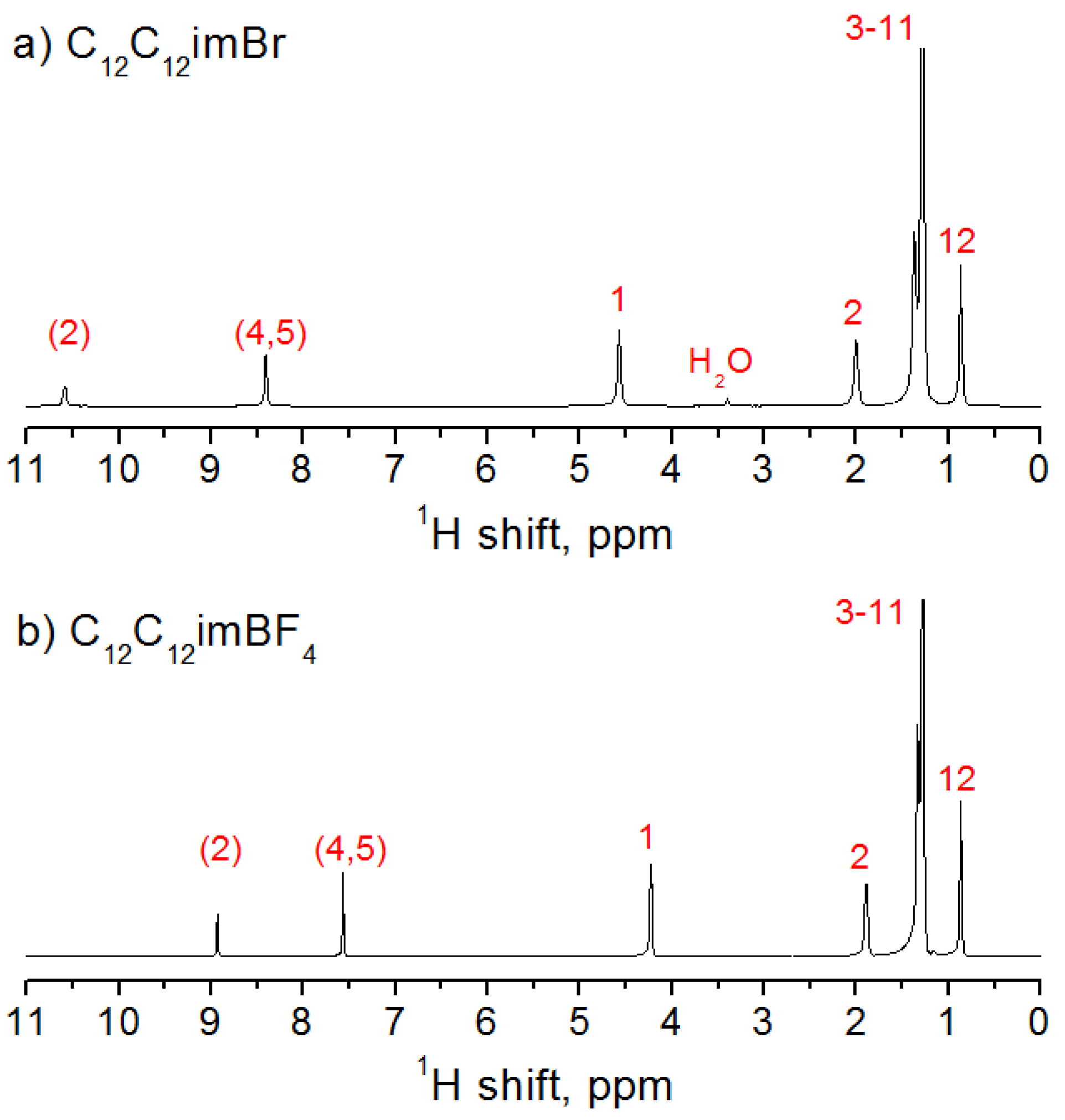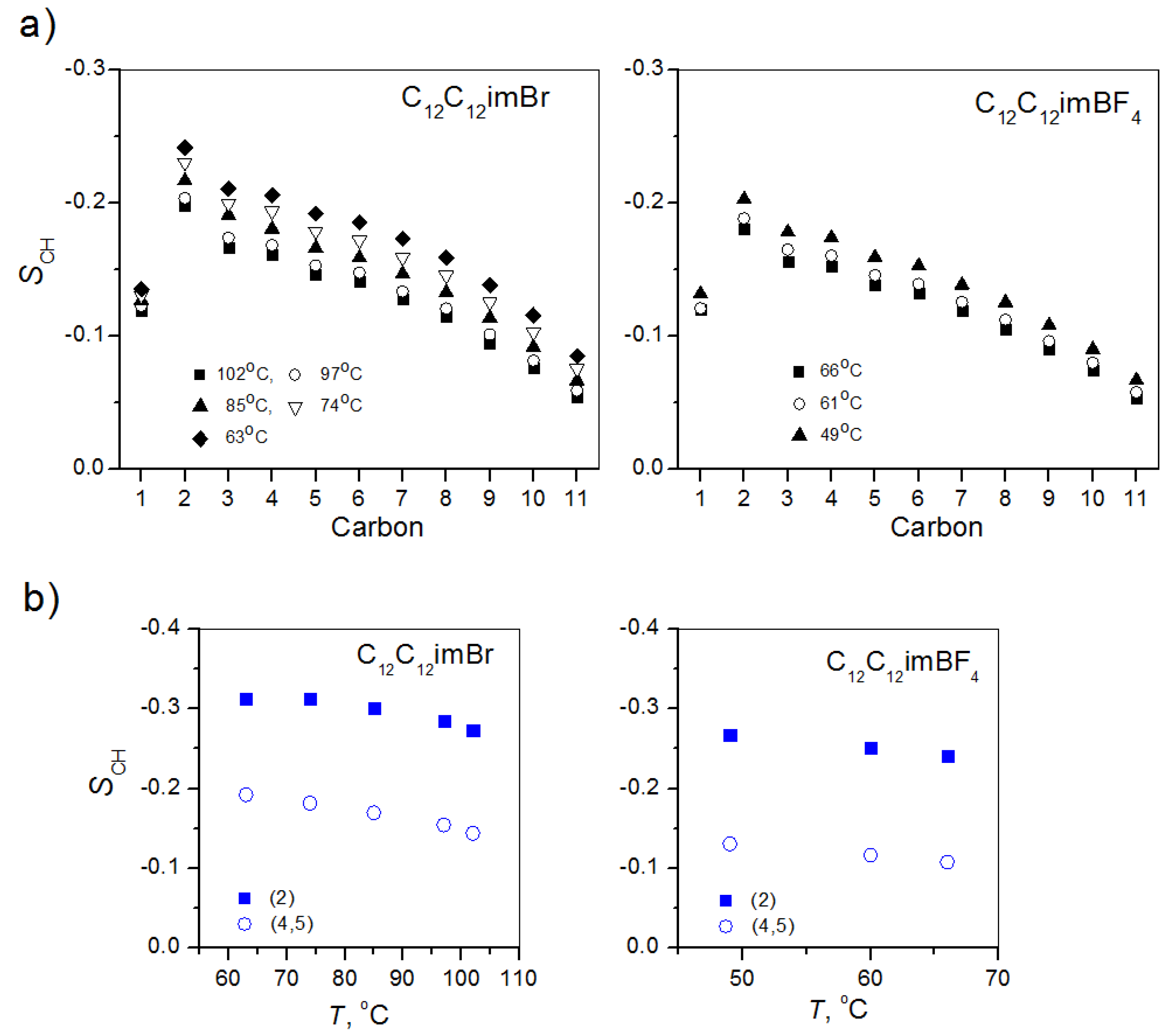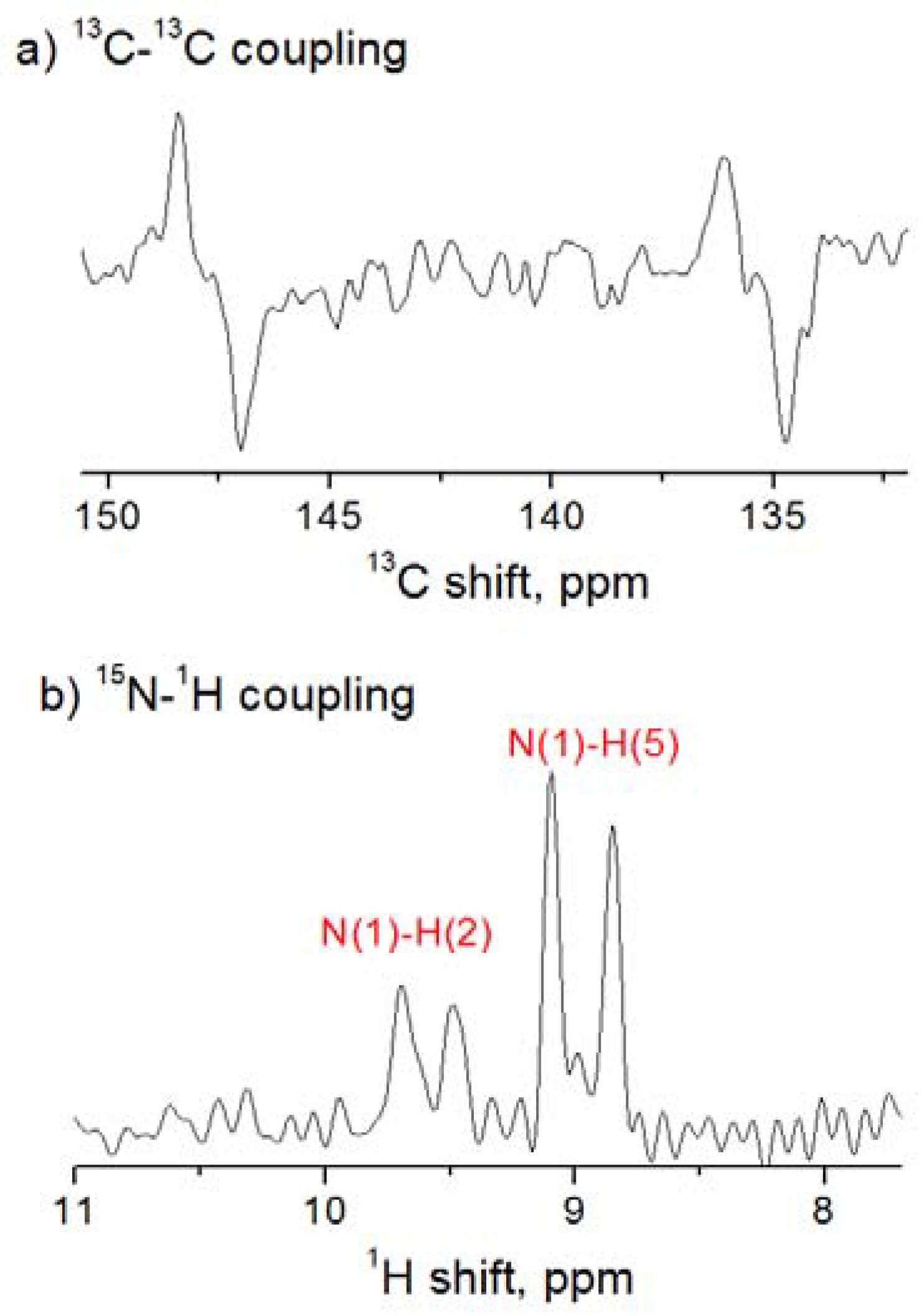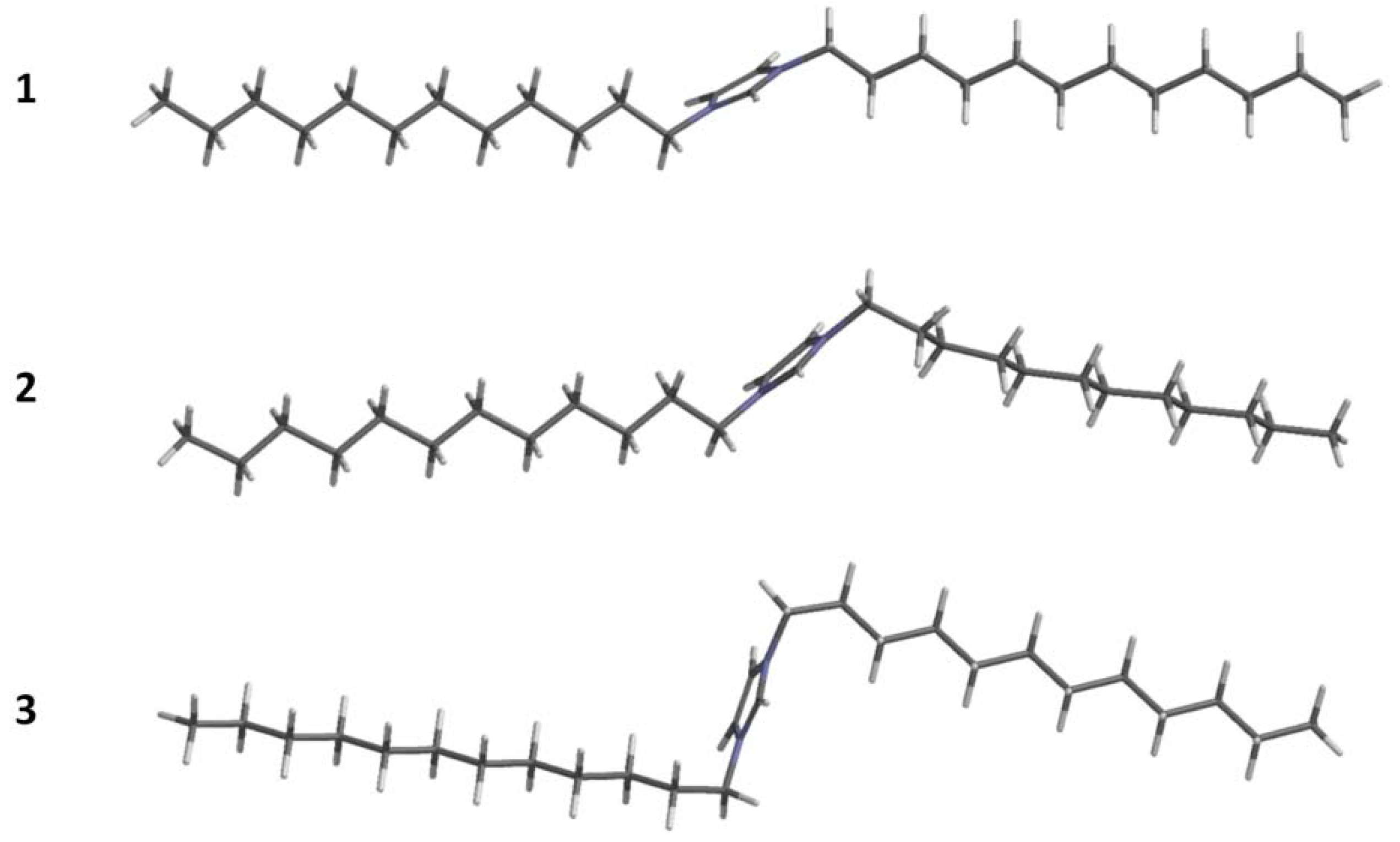NMR Spectroscopic Studies of Cation Dynamics in Symmetrically-Substituted Imidazolium-Based Ionic Liquid Crystals
Abstract
:1. Introduction
2. Results and Discussion
2.1. NMR Spectra
2.2. Alkyl Chain Local Order
2.3. Imidazolium Core Alignment
2.4. Comparison to Crystal Structures and DFT Optimized Cation Geometry
2.5. Order Parameters
3. Materials and Methods
3.1. Synthesis
3.2. NMR Methods
3.3. Computational Method
4. Conclusions
Supplementary Materials
Author Contributions
Funding
Conflicts of Interest
Abbreviations
| C12C12imBr | bis-1,3-dodecyl imidazolium bromide |
| C12C12imBF4 | bis-1,3-dodecyl imidazolium tetrafluoroborate |
| CS | chemical shift |
| DFT | density functional theory |
| ILs | ionic liquids |
| ILCs | ionic liquid crystals |
| INADEQUATE | incredible natural abundance double quantum transfer experiment |
| NAD | natural abundance deuterium (spectroscopy) |
| off-MAS | off-magic angle sample spinning |
| PDLF | proton detected/encoded local field (spectroscopy) |
References
- Goossens, K.; Lava, K.; Bielawski, C.W.; Binnemans, K. Ionic liquid crystals: Versatile materials. Chem. Rev. 2016, 116, 4643–4807. [Google Scholar] [CrossRef] [PubMed]
- Lennert, A.; Sternberg, M.; Meyer, K.; Costa, R.D.; Guldi, D.M. Iodine-pseudohalogen ionic liquid-based electrolytes for quasi-solid-state dye-sensitized solar cells. ACS Appl. Mater. Interfaces 2017, 9, 33437–33445. [Google Scholar] [CrossRef] [PubMed]
- Costa, R.D.; Werner, F.; Wang, X.J.; Gronninger, P.; Feihl, S.; Kohler, F.T.U.; Wasserscheid, P.; Hibler, S.; Beranek, R.; Meyer, K.; et al. Beneficial effects of liquid crystalline phases in solid-state dye-sensitized solar cells. Adv. Energy Mater. 2013, 3, 657–665. [Google Scholar] [CrossRef]
- Zhang, G.X.; Tao, L.; Zhang, G.Y. Effect of hydrophobic carbon chain length on the crystal structure of MCM-41. Chin. J. Chem. Eng. 2008, 16, 631–634. [Google Scholar] [CrossRef]
- Adams, C.J.; Bradley, A.E.; Seddon, K.R. The synthesis of mesoporous materials using novel ionic liquid templates in water. Aus. J. Chem. 2001, 54, 679–681. [Google Scholar] [CrossRef]
- Liu, C.H.; Yu, X.Y.; Yang, J.G.; He, M.Y. Preparation of mesoporous Al-MCM-41 with stable tetrahedral aluminum using ionic liquids as a single template. Mater. Lett. 2007, 61, 5261–5264. [Google Scholar] [CrossRef]
- Kohler, F.T.U.; Morain, B.; Weiss, A.; Laurin, M.; Libuda, J.; Wagner, V.; Melcher, B.U.; Wang, X.J.; Meyer, K.; Wasserscheid, P. Surface-functionalized ionic liquid crystal-supported ionic liquid phase materials: Ionic liquid crystals in mesopores. Chem. Phys. Chem. 2011, 12, 3539–3546. [Google Scholar] [CrossRef]
- Lee, C.K.; Huang, H.W.; Lin, I.J.B. Simple amphiphilic liquid crystalline N-alkylimidazolium salts. A new solvent system providing a partially ordered environment. Chem. Commun. 2000, 1911–1912. [Google Scholar] [CrossRef]
- Douce, L.; Suisse, J.M.; Guillon, D.; Taubert, A. Imidazolium-based liquid crystals: A modular platform for versatile new materials with finely tuneable properties and behaviour. Liq. Cryst. 2011, 38, 1653–1661. [Google Scholar] [CrossRef]
- Wang, X.J.; Heinemann, F.W.; Yang, M.; Melcher, B.U.; Fekete, M.; Mudring, A.V.; Wasserscheid, P.; Meyer, K. A new class of double alkyl-substituted, liquid crystalline imidazolium ionic liquids—A unique combination of structural features, viscosity effects, and thermal properties. Chem. Commun. 2009, 7405–7407. [Google Scholar] [CrossRef]
- Sobota, M.; Wang, X.J.; Fekete, M.; Happel, M.; Meyer, K.; Wasserscheid, P.; Laurin, M.; Libuda, J. Ordering and phase transitions in ionic liquid-crystalline films. Chem. Phys. Chem. 2010, 11, 1632–1636. [Google Scholar] [CrossRef]
- Goossens, K.; Rakers, L.; Shin, T.J.; Honeker, R.; Bielawski, C.W.; Glorius, F. Substituted azolium disposition: Examining the effects of alkyl placement on thermal properties. Crystals 2019, 9, 34. [Google Scholar] [CrossRef] [Green Version]
- Rohini, R.; Lee, C.K.; Lu, J.T.; Lin, I.J.B. Symmetrical 1,3-dialkylimidazolium based ionic liquid crystals. J. Chin. Chem. Soc. 2013, 60, 745–754. [Google Scholar] [CrossRef]
- Wang, X.J.; Sternberg, M.; Kohler, F.T.U.; Melcher, B.U.; Wasserscheid, P.; Meyer, K. Long-alkyl-chain-derivatized imidazolium salts and ionic liquid crystals with tailor-made properties. RSC Adv. 2014, 4, 12476–12481. [Google Scholar] [CrossRef] [Green Version]
- Yang, M.; Mallick, B.; Mudring, A.V. A systematic study on the mesomorphic behavior of asymmetrical 1-alkyl-3-dodecylimidazolium bromides. Cryst. Growth. Des. 2014, 14, 1561–1571. [Google Scholar] [CrossRef] [Green Version]
- Yang, M.; Mallick, B.; Mudring, A.V. On the mesophase formation of 1,3-dialkylimidazolium ionic liquids. Cryst. Growth. Des. 2013, 13, 3068–3077. [Google Scholar] [CrossRef] [Green Version]
- Chiou, J.Y.Z.; Chen, J.N.; Lei, J.S.; Lin, I.J.B. Ionic liquid crystals of imidazolium salts with a pendant hydroxyl group. J. Mater. Chem. 2006, 16, 2972–2977. [Google Scholar] [CrossRef]
- Dvinskikh, S.V. Characterization of liquid-crystalline materials by separated local field methods. In Modern Methods in Solid-State NMR: A Practitioners’ Guide; Hodgkinson, P., Ed.; Royal Society of Chemistry: Abingdon, UK, 2018. [Google Scholar]
- Majhi, D.; Dai, J.; Komolkin, A.B.; Dvinskikh, S.V. Understanding ionic mesophase stabilization by hydration: A solid-state NMR study. Phys. Chem. Chem. Phys. 2020, 22, 13408–13417. [Google Scholar] [CrossRef]
- Dai, J.; Kharkov, B.B.; Dvinskikh, S.V. Molecular and segmental orientational order in a smectic mesophase of a thermotropic ionic liquid crystal. Crystals 2019, 9, 18. [Google Scholar] [CrossRef] [Green Version]
- Dai, J.; Majhi, D.; Kharkov, B.B.; Dvinskikh, S.V. NMR spectroscopic study of orientational order in imidazolium-based ionic liquid crystals. Crystals 2019, 9, 495. [Google Scholar] [CrossRef] [Green Version]
- Cifelli, M.; Domenici, V.; Chizhik, V.I.; Dvinskikh, S.V. 15N–13C dipole couplings in smectic mesophase of a thermotropic ionic liquid. Appl. Magn. Reson. 2018, 49, 553–562. [Google Scholar] [CrossRef] [PubMed] [Green Version]
- Mann, S.K.; Devgan, M.K.; Franks, W.T.; Huband, S.; Chan, C.L.; Griffith, J.; Pugh, D.; Brooks, N.J.; Welton, T.; Pham, T.N.; et al. MAS NMR investigation of molecular order in an ionic liquid crystal. J. Phys. Chem. B 2020, 124, 4975–4988. [Google Scholar] [CrossRef] [PubMed]
- Lesot, P.; Courtieu, J. Natural abundance deuterium NMR spectroscopy: Developments and analytical applications in liquids, liquid crystals and solid phases. Progr. Nucl. Magn. Reson. Spectrosc. 2009, 55, 128–159. [Google Scholar] [CrossRef]
- Wang, M.; Pan, X.; Xiao, S.F.; Zhang, C.N.; Li, W.X.; Dai, S.Y. Regulating mesogenic properties of ionic liquid crystals by preparing binary or multi-component systems. J. Mater. Chem. 2012, 22, 2299–2305. [Google Scholar] [CrossRef]
- Fernandez, A.A.; Kouwer, P.H.J. Key Developments in ionic liquid crystals. Int. J. Mol. Sci. 2016, 17, 731. [Google Scholar] [CrossRef] [Green Version]
- Bradley, A.E.; Hardacre, C.; Holbrey, J.D.; Johnston, S.; McMath, S.E.J.; Nieuwenhuyzen, M. Small-angle X-ray scattering studies of liquid crystalline 1-alkyl-3-methylimidazolium salts. Chem. Mater. 2002, 14, 629–635. [Google Scholar] [CrossRef]
- Nakai, T.; Terao, T. Measurements of heteronuclear dipolar powder patterns due only to directly bonded couplings. Magn. Reson. Chem. 1992, 30, 42–44. [Google Scholar] [CrossRef]
- Burum, D.P.; Linder, M.; Ernst, R.R. Low-power multipulse line narrowing in solid-state NMR. J. Magn. Reson. 1981, 44, 173–188. [Google Scholar] [CrossRef]
- Breitmaier, E.; Voelter, W. Carbon-13 NMR Spectroscopy. High-Resolution Methods and Applications in Organic Chemistry and Biochemistry; VCH: Weinheim, Germany, 1990. [Google Scholar]
- Emsley, J.W.; Lesot, P.; De Luca, G.; Lesage, A.; Merlet, D.; Pileio, G. A comparison of proton-detected C-13 local field experiments with deuterium NMR at natural abundance for studying liquid crystals. Liq. Cryst. 2008, 35, 443–464. [Google Scholar] [CrossRef]
- Wulf, A.; Fumino, K.; Michalik, D.; Ludwig, R. IR and NMR properties of ionic liquids: Do they tell us the same thing? Chem. Phys. Chem. 2007, 8, 2265–2269. [Google Scholar] [CrossRef]
- Sarkar, R.; Camargo, D.C.R.; Pintacuda, G.; Reif, B. Restoring resolution in biological solid-state NMR under conditions of off-magic-angle spinning. J. Phys. Chem. Lett. 2015, 6, 5040–5044. [Google Scholar] [CrossRef] [PubMed]
- Dvinskikh, S.V.; Zimmermann, H.; Maliniak, A.; Sandström, D. Measurements of motionally averaged heteronuclear dipolar couplings in MAS NMR using R-type recoupling. J. Magn. Reson. 2004, 168, 194–201. [Google Scholar] [CrossRef] [PubMed]
- Dvinskikh, S.V.; Sandström, D. Frequency offset refocused PISEMA-type sequences. J. Magn. Reson. 2005, 175, 163–169. [Google Scholar] [CrossRef] [PubMed]
- Lee, C.K.; Peng, H.H.; Lin, I.J.B. Liquid crystals of N,N ’-dialkylimidazolium salts comprising palladium(II) and copper(II) ions. Chem. Mater. 2004, 16, 530–536. [Google Scholar] [CrossRef]
- Wang, X.J.; Vogel, C.S.; Heinemann, F.W.; Wasserscheid, P.; Meyer, K. Solid-state structures of double-long-chain imidazolium ionic liquids: Influence of anion shape on cation geometry and crystal packing. Cryst. Growth. Des. 2011, 11, 1974–1988. [Google Scholar] [CrossRef]
- Greeson, K.T.; Hall, N.G.; Redeker, N.D.; Marcischak, J.C.; Gilmore, L.V.; Boatz, J.A.; Le, T.C.; Alston, J.R.; Guenthner, A.J.; Ghiassi, K.B. Synthesis and properties of symmetrical N,N′-bis(alkyl)imidazolium bromotrichloroferrate(III) paramagnetic, room temperature ionic liquids with high short-term thermal stability. J. Mol. Liq. 2018, 265, 701–710. [Google Scholar] [CrossRef]
- McMillan, W.L. Simple molecular model for the smectic A phase of liquid crystal. Phys. Rev. A 1971, 4, 1238–1246. [Google Scholar] [CrossRef]
- Constant, M.; Decoster, D. Raman-scattering—Investigation of nematic and smectic ordering. J. Chem. Phys. 1982, 76, 1708–1711. [Google Scholar] [CrossRef]
- Fung, B.M.; Poon, C.-D.; Gangoda, M.; Enwall, E.L.; Diep, T.A.D.; Bui, C.V. Nematic and smectic ordering of 4-n-octyl-4′-cyanobiphenyl studied by carbon-13 NMR. Mol. Cryst. Liq. Cryst. 1986, 141, 267–277. [Google Scholar] [CrossRef]
- Shirota, H.; Mandai, T.; Fukazawa, H.; Kato, T. Comparison between dicationic and monocationic ionic liquids: Liquid density, thermal properties, surface tension, and shear viscosity. J. Chem. Eng. Data 2011, 56, 2453–2459. [Google Scholar] [CrossRef]
- Giernoth, R.; Bankmann, D. Transition-metal free ring deuteration of imidazolium ionic liquid cations. Tetrahedron Lett. 2006, 47, 4293–4296. [Google Scholar] [CrossRef]
- Di Pietro, M.E.; Margola, T.; Celebre, G.; De Luca, G.; Saielli, G. A combined LX-NMR and molecular dynamics investigation of the bulk and local structure of ionic liquid crystals. Soft Matter 2019, 15, 4486–4497. [Google Scholar] [CrossRef] [PubMed]
- Fung, B.M.; Khitrin, A.K.; Ermolaev, K. An improved broadband decoupling sequence for liquid crystals and solids. J. Magn. Reson. 2000, 142, 97–101. [Google Scholar] [CrossRef] [PubMed]
- Dvinskikh, S.V.; Zimmermann, H.; Maliniak, A.; Sandström, D. Separated local field spectroscopy of columnar and nematic liquid crystals. J. Magn. Reson. 2003, 163, 46–55. [Google Scholar] [CrossRef]
- Sandström, D.; Levitt, M.H. Structure and molecular ordering of a nematic liquid crystal studied by natural-abundance double-quantum 13C NMR. J. Am. Chem. Soc. 1996, 118, 6966–6974. [Google Scholar] [CrossRef]
- Shao, Y.; Molnar, L.F.; Jung, Y.; Kussmann, J.; Ochsenfeld, C.; Brown, S.T.; Gilbert, A.T.B.; Slipchenko, L.V.; Levchenko, S.V.; O’Neill, D.P.; et al. Advances in methods and algorithms in a modern quantum chemistry program package. Phys. Chem. Chem. Phys. 2006, 8, 3172–3191. [Google Scholar] [CrossRef]









© 2020 by the authors. Licensee MDPI, Basel, Switzerland. This article is an open access article distributed under the terms and conditions of the Creative Commons Attribution (CC BY) license (http://creativecommons.org/licenses/by/4.0/).
Share and Cite
Majhi, D.; Komolkin, A.V.; Dvinskikh, S.V. NMR Spectroscopic Studies of Cation Dynamics in Symmetrically-Substituted Imidazolium-Based Ionic Liquid Crystals. Int. J. Mol. Sci. 2020, 21, 5024. https://doi.org/10.3390/ijms21145024
Majhi D, Komolkin AV, Dvinskikh SV. NMR Spectroscopic Studies of Cation Dynamics in Symmetrically-Substituted Imidazolium-Based Ionic Liquid Crystals. International Journal of Molecular Sciences. 2020; 21(14):5024. https://doi.org/10.3390/ijms21145024
Chicago/Turabian StyleMajhi, Debashis, Andrei V. Komolkin, and Sergey V. Dvinskikh. 2020. "NMR Spectroscopic Studies of Cation Dynamics in Symmetrically-Substituted Imidazolium-Based Ionic Liquid Crystals" International Journal of Molecular Sciences 21, no. 14: 5024. https://doi.org/10.3390/ijms21145024




